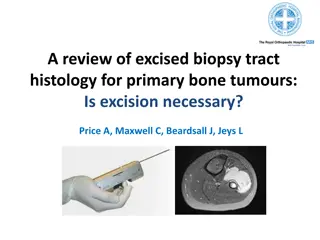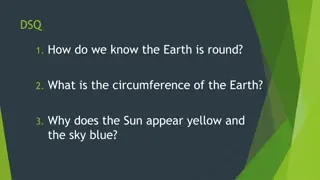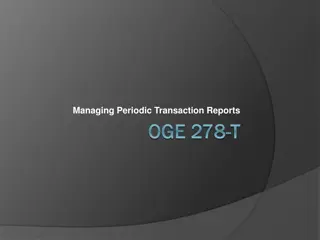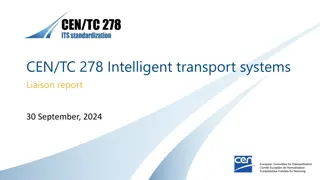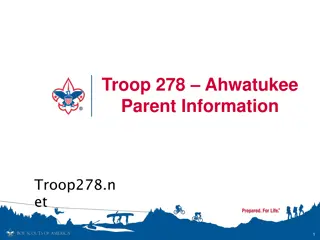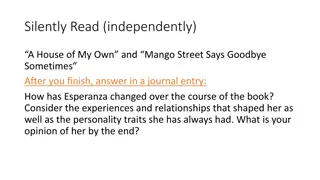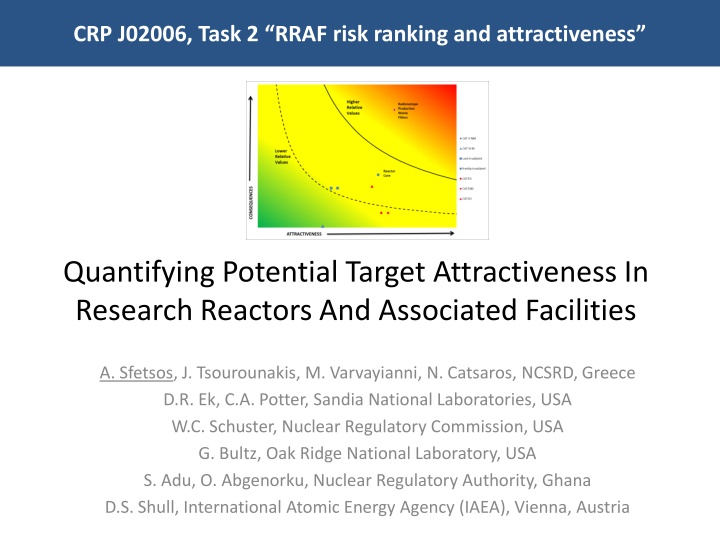
Quantifying Potential Target Attractiveness in Research Reactors
Explore the methodology for assessing and quantifying relative risk in research reactors by determining the attractiveness of nuclear material/radioactive material and accounting for consequences based on identified events such as unauthorized removal and sabotage. Factors such as accessibility, location, potential to weaponize, ease of handling/detection avoidance, and portability are key considerations in this risk ranking process.
Download Presentation

Please find below an Image/Link to download the presentation.
The content on the website is provided AS IS for your information and personal use only. It may not be sold, licensed, or shared on other websites without obtaining consent from the author. If you encounter any issues during the download, it is possible that the publisher has removed the file from their server.
You are allowed to download the files provided on this website for personal or commercial use, subject to the condition that they are used lawfully. All files are the property of their respective owners.
The content on the website is provided AS IS for your information and personal use only. It may not be sold, licensed, or shared on other websites without obtaining consent from the author.
E N D
Presentation Transcript
CRP J02006, Task 2 RRAF risk ranking and attractiveness Quantifying Potential Target Attractiveness In Research Reactors And Associated Facilities A. Sfetsos, J. Tsourounakis, M. Varvayianni, N. Catsaros, NCSRD, Greece D.R. Ek, C.A. Potter, Sandia National Laboratories, USA W.C. Schuster, Nuclear Regulatory Commission, USA G. Bultz, Oak Ridge National Laboratory, USA S. Adu, O. Abgenorku, Nuclear Regulatory Authority, Ghana D.S. Shull, International Atomic Energy Agency (IAEA), Vienna, Austria
CRP J02006, Task 2 RRAF risk ranking and attractiveness Objective of CRP J02006 Task 2 Identify factors for developing a comprehensive normalized ranking scheme for security risk posed by NM/RM considering the unique characteristics of RRAFs. Develop a methodology to compare seemingly dis-similar types of events (unauthorized removal and/or sabotage) and also different types of NM/RM to support risk informed decisions for improving RRAF physical protection regimes. Iterative process presented and discussed within CRP and RR Conference ICONS 2020, Vienna Austria
CRP J02006, Task 2 RRAF risk ranking and attractiveness Identified types of events Unauthorized removal with the intent to construct an improvised nuclear device (IND); Unauthorized removal which could lead to use in a subsequent radiological dispersal device (RDD); Unauthorized removal which could lead to use in a subsequent radiological exposure device (RED); Risk of sabotage to research reactor (RR) nuclear material / core Risk of sabotage to RR other radioactive materials ICONS 2020, Vienna Austria
CRP J02006, Task 2 RRAF risk ranking and attractiveness Methodology Assess and quantify relative risk through the determination of Attractiveness of NM/RM and Consequences Accounting collectively for every possible event per NM/RM Category type. It does not consider the effectiveness of the physical protection measures or the threat environment Word Ladder and Scales (VERY LOW / LOW / MEDIUM / HIGH / VERY HIGH) ICONS 2020, Vienna Austria
CRP J02006, Task 2 RRAF risk ranking and attractiveness Attractiveness Factors Overview Factor Relative Scaling Accessibility 25% RRAF location 10% Potential to weaponize 55% Ease of handling / Detection avoidance 5% Portability 5% ICONS 2020, Vienna Austria
CRP J02006, Task 2 RRAF risk ranking and attractiveness Attractiveness factors - 1 Accessibility: material/radioactive material (NM/RM) inside the facility by an external adversary is captured by the number of locked boundary layers the material is contained within. The most attractive target is the one with no boundary layers, and the attractiveness value is reduced by adding extra boundary layers. The accessibility to the location of nuclear Attractiveness 1 - Very Low 2 - Low 3 -Medium 4 - High 5 - Very High Relative scaling Target accessibility 4 or more layers 3 layers 2 layers 1 layer no layers 25% ICONS 2020, Vienna Austria
CRP J02006, Task 2 RRAF risk ranking and attractiveness Attractiveness factors - 2 Facility location: This factor provides an estimation of the attractiveness based on the location of a facility. Attractiveness 1 - Very Low 2 - Low 3 -Medium 4 - High 5 - Very High Relative scaling significant agriculture / infrastructur es city centre / highly populated low national monument / iconic site Major public event RRAF location population density 10% ICONS 2020, Vienna Austria
CRP J02006, Task 2 RRAF risk ranking and attractiveness Attractiveness factors - 3 Potential to weaponize. The proposed factor is a combination of: a) the relative ease at which a potential adversary can initiate a security event based on NM/RM material type, category and form and b) a composite indicator accounting for all possible types of events that can be initiated by an adversary. Table below shows relative difficulty to initiate event. Each type of material has been assigned a relative weighting factor. Relative Scaling 55% NM / RM sabotage Event IND RDD RED Difficulty to weaponize 0.5% 42% 25% 32.5% ICONS 2020, Vienna Austria
CRP J02006, Task 2 RRAF risk ranking and attractiveness Attractiveness factors - 4 Ease of handling / detection avoidance, which is linked to the NM/RM radioactivity. Unirradiated nuclear material is perceived as the easiest target type to handle and avoid detection, as compared to high energy gamma emitting ( ) sources that require additional shielding to reduce risk of biological effects and avoid detection. Attractiveness 1 - Very Low 3 -Medium 5 - Very High Relative scaling ease of handling / detection avoidance Unirradiated nuclear material and other alpha > 1MeV /decay >0.75 MeV /decay >0.5 MeV /decay <0. 5 MeV /decay 5% ICONS 2020, Vienna Austria
CRP J02006, Task 2 RRAF risk ranking and attractiveness Attractiveness factors - 5 The portability factor is linked to the size and weight of the target material and can include shielding. The most attractive material is the one that can be handheld and easily man- portable. Attractiveness 1 - Very Low 3 -Medium 5 - Very High Relative scaling Hand Truck Portability Truck Handheld 5% ICONS 2020, Vienna Austria
CRP J02006, Task 2 RRAF risk ranking and attractiveness Consequences Human health. These may include casualties (deaths and injuries) caused by the device (e.g. resulting from an explosion) as well as exposure to radiation or intakes of radionuclides. Economic costs. May include assumed relative cost factors addressing impacts on people, property and the environment and also account for the [scaled] half- life of cool / fresh irradiated NM and RM A [scaled] thermal power factor also accounts for the RRAF (cool / freshly irradiated NM) A composite indicator accounting for the consequences for all possible types of malicious actions that can be initiated by an adversary is proposed to contain a weighted estimate of the health (75%) and economic (25%) components. FINAL VALUE = (75% * HEALTH + 25% * ECONOMIC * HALF- LIFE_SCALE)* THERMAL_POWER_SCALE ICONS 2020, Vienna Austria
CRP J02006, Task 2 RRAF risk ranking and attractiveness Key results Example application on IAEA virtual facilities Operator perspective Hypothetical Atomic Research Institute (HARI). University Medical Center (UMC) Shapash Nuclear Research Institute (SNRI) HARI Security upgrades Regulator perspective A comparison of all facilities ICONS 2020, Vienna Austria
CRP J02006, Task 2 RRAF risk ranking and attractiveness HARI ICONS 2020, Vienna Austria
CRP J02006, Task 2 RRAF risk ranking and attractiveness HARI RPWF Security Upgrades ICONS 2020, Vienna Austria
CRP J02006, Task 2 RRAF risk ranking and attractiveness UMC ICONS 2020, Vienna Austria
CRP J02006, Task 2 RRAF risk ranking and attractiveness Shapash ICONS 2020, Vienna Austria
CRP J02006, Task 2 RRAF risk ranking and attractiveness Comparison of facilities ICONS 2020, Vienna Austria
CRP J02006, Task 2 RRAF risk ranking and attractiveness Conclusions Develop a methodology to compare NM and RM under a common risk ranking scheme Potential applications can include: Ranking of respective targets in a RRAF that could be further assessed in terms of vulnerabilities and physical protection measures. Identification of groups of RN/NM based on the risk ranking scheme that could be considered as higher priority for further analysis of physical protection measures, and risk-informed security upgrades. Definition of potential targets that could be tested in nuclear security capacity building activities ICONS 2020, Vienna Austria
CRP J02006, Task 2 RRAF risk ranking and attractiveness Many thanks !!!! Questions Email: ts@ipta.demokritos.gr You are cordially invited to the side event Assessing Attractiveness of Nuclear Materials and Radiological Materials for Research Reactors Date and Time:Thursday 13 February 2020; 12:30 - 14:00 Venue:Conference Room M5, M Building, Ground Floor We are seeking your valuable feedback on the merits and suggestions for improvement of the proposed approach. ICONS 2020, Vienna Austria














